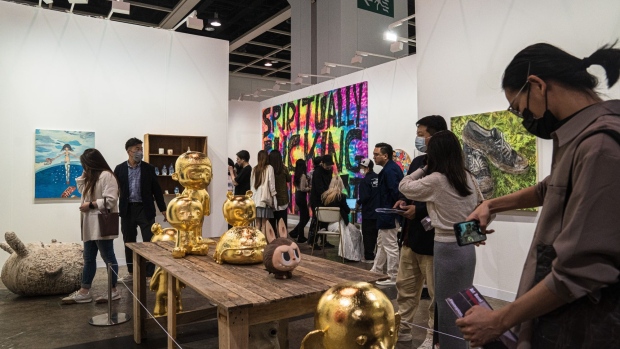Mar 23, 2023
Art Basel Hong Kong Welcomes Back Wealthy Chinese Collectors After Three Years
, Bloomberg News

(Bloomberg) -- As Art Basel returns to Hong Kong on a full-fledged scale after years of disruptions, a major gauge of success for the art fair will be how much wealthy collectors from mainland China spend as they travel once again after Covid restrictions ended.
Chinese attendees are grouping together to take private jets to Hong Kong, according to White Cube Asia General Manager Wendy Xu, and galleries in neighboring Guangdong province are organizing tours for collectors, according to their WeChat accounts.
Cherry Xu, 29, has already liaised with galleries for three pieces of work she is interested in before flying to Hong Kong from Shanghai. She has about 100 pieces of art across two warehouses in the cities.
“It’s as if every few steps I take, I bump into someone from the Chinese art industry I have heard about but only see in person now,” said Xu during the first day of the VIP preview on March 21.
Chinese collectors account for the world’s highest share of spending at the $1 million level, and their median expenditure is the highest globally at $475,000 for a piece of art, according to a UBS Group AG report last year. But sales of Chinese traditional paintings, among others, declined in 2022 due to economic uncertainty and China’s Covid Zero policy, Sotheby’s said in a report this month.
Lockdowns last year temporarily “cast a bit of a chill” on the market, said Nick Simunovic, director of the Gagosian gallery in Hong Kong, adding that “basically anybody who came to Art Basel in the past from China will come again this time.” Simunovic said he is also watching new Chinese collectors who have entered the scene in the last three years.
Among these are Hangzhou-based Ethan Chai, who is going to Art Basel for the first time and who has his eyes on a painting by Swiss painter Lenz Geerk.
“There are so, so many people here. For a collector, to be able to travel, the interaction and being able to see a work in person is different from looking at a PDF,” said the 25 year-old, who started collecting before the pandemic hit with the help of galleries and overseas art advisors. He now has a space in Hangzhou where he displays some of his collection and holds exhibitions for young artists.
Mainland collectors are getting younger and have more international pieces compared with older collectors as many of them are well-traveled, said Pearl Lam of Pearl Lam Galleries. Collectors in their 20s or early 30s are willing to spend seven figures on a piece of work, said Lam, who has been advising mainland collectors since 1993.
Art Basel Hong Kong, which runs until March 25, is hosting 177 galleries this year compared with 130 last year, and the event was held in a scaled-down, hybrid format 2021. As Hong Kong was shut off from the world, other cities in the region tried to capitalize on opportunity — Seoul held its first Frieze Fair in September, and Singapore launched a new art fair in January.
However, Philip Hoffman, founder and chief executive of art advisory and investment firm The Fine Art Group, believes that Hong Kong remains the main regional hub.
“Singapore was not as strong as we expected. The Chinese weren’t as evident in Singapore, nor did many of the big collectors go,” he said.
One major advantage of Hong Kong for art collectors is low costs, as the city has no customs duty, value-added taxes or estate duty on artworks, while Singapore has a goods and services tax of 8%. Hong Kong also has more robust logistics and warehousing facilities for storage. In a sign of confidence in the city’s art market, three of the world’s top auction houses have committed to expanding their offices in Hong Kong.
In the first few days of Art Basel, Hauser & Wirth sold a George Condo piece for $4.75 million to a private collection based between Hong Kong and Los Angeles and placed several others with China collectors including the Long Museum in Shanghai. White Cube placed a work by Anselm Kiefer for $1.09 million and a Damien Hirst piece for $525,000, both to collectors in China.
Nonetheless, the turmoil in the global economy is having an impact on the art market. While prices last year benefited as investors turned to the asset class as a haven, worsening economic conditions means it will be a “very particular” year for the market, said Leo Xu, senior director at David Zwirner gallery.
Collectors will be more discerning and look for blue-chip artists who will withstand the test of time, instead of works that might be cheaper alternatives. Xu said people are likely to “think twice” before buying something that’s just “something like Picasso” instead of the real thing.
“Is that going to last?” he said. “People will not chase those fleeting phenomenon.”
(Corrects Art Basel Hong Kong’s 2021 format in ninth paragraph.)
©2023 Bloomberg L.P.


